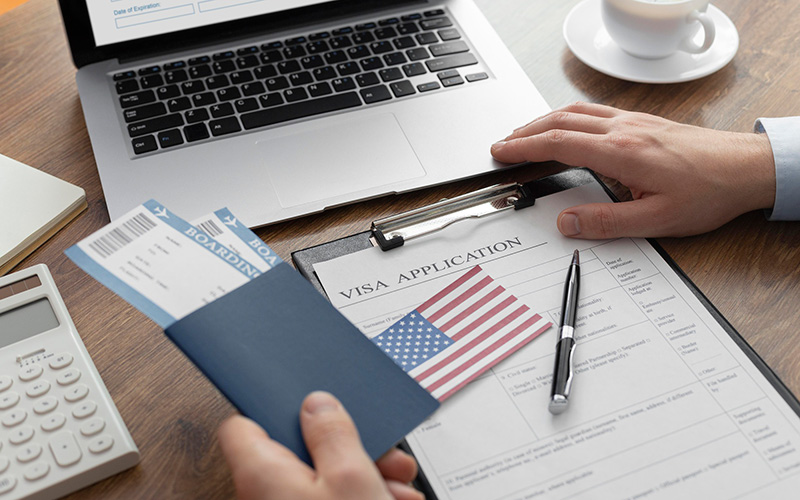US Business Visa Guide: Eligibility, Process & Requirements
While obtaining a business visa for visiting the United States may seem overwhelming, if you do the necessary preparations, the procedure will be far easier. If you’re coming to the U.S. to hold meetings, consult with partners, sign a deal or attend a conference, the B-1 visa is the one. We have put together this guide to ensure you know exactly what papers to submit while applying for this visa. This would allow you to focus more on your business goals and less on paperwork. By the end, you’ll know not just how to apply, but also what paperwork you’ll need, how long this process should take and what the common Business visa USA requirements are.
Who Can Apply for the US Business Visa
The B1 Visa USA is for attending a meeting, consultation, seminar, or conference, and negotiating a business contract among others. You should also keep in mind that this visa allows you to neither work in the U.S. nor receive payment from a U.S. company. Your trip must be shown to be short-term and for bona fide business reasons.
To qualify as a visitor, you must demonstrate that you:
- Have a legitimate reason for visiting
- Possess a strong intent to return home
- Have enough funds to support your visit without having to work while in the U.S.
A large part of this visa is showing your propensity to return to your home country to things like a job, family or property that clearly demonstrate that you will leave after your visit. You also must not plan to reside in the United States permanently. Those with a history or pattern of overstaying visas, or limited ties to their home country, may have a more difficult time getting approved.
Steps to Apply for a US Business Visa

- First, you’ll have to complete Form DS-160, which is the general form you use to apply for a non-immigrant US tourist visa. This form is filled out online and includes questions about your personal background, travel plans, and security information.
- Be sure to double-check your answers for errors that can slow your application down or get it rejected.
- Once you fill out the form, you will be taken to make a payment for the visa fee, which is now $185. This fee is non-refundable regardless of whether or not your visa is rejected.
- After you pay, you’ll get confirmation to schedule an appointment at the nearest U.S. embassy or consulate.
- When you attend your appointment, you must bring documents such as your passport, your DS-160 confirmation page, a recent passport photo and proof of payment, and any other paperwork that supports your business trip. These can include an invitation letter from the U.S. company, certificates of business registration, or proof of previous transactions with the U.S. company you’re visiting.
- You should also have evidence of ties to your home country and financial statements that show you can pay for your visit. The consular officer will also interview you to verify your intentions and determine if you fulfill all US business visa requirements.
Documents You’ll Need to Submit
- During an interview, you have to take a bunch of crucial documents with you.
- You want your passport to be valid for at least six months beyond your intended stay in the U.S. and have at least two blank pages.
- An acceptable recent photo according to U.S. visa photo procedures and a printed confirmation page of your DS-160 form.
- You will also need to provide confirmation that you have paid the visa fee.
- If your trip is sponsored by your employer, you will need a letter from your company outlining your role, why you’re traveling and guaranteeing that your expenses will be paid.
- You’ll also need an invitation letter from the U.S. business or organization you’re visiting. Other documents show evidence of your business ties, such as previous contracts or communications with the United States company.
- You may also be asked to present tax records, proof of property or other personal records that show you have reasons to return home.
All of these along with necessary US Business Visa FAQs will help show that your trip to the U.S. is temporary and strictly business-related.
What the Interview Is Like
The interview is an important step in the visa process. A consular officer will evaluate if your reasons for visiting the U.S. are genuine and time limited. You’ll be questioned on your employment, your intentions in the U.S. and your history. They may also inquire about your financial means to confirm that you won’t have to work while in the U.S., and answer honestly and clearly.
It’s natural to feel nervous, but you are not alone. Limit what you carry to what you need, keep it organized, and be respectful. If your circumstances are unique, it is not unusual for further questions to be posed. For example, if you’ve traveled to the U.S. before, they might ask you about past visits. If you’ve ever overstayed a visa, come clean and explain this in your application.
The officer’s job is to decide if you’re coming back home after your trip. If they are satisfied, they may approve your visa then and there, but sometimes it can require additional administrative processing.
How Long does the Visa Process take
US business visa processing time for US business visa varies based on a few factors, such as the schedule of your local U.S. embassy or consulate, volume of business visa applications, as well as any additional checks that may be required. After your interview, your application could be approved on the spot, or it may be placed in administrative processing, which may also take a long period.
Most applications are generally processed and decision is made within days or a couple of weeks. But it’s always safer to apply at least two to three months before your travel plans. Interviews at embassies in big cities could result in longer wait times though, while some could be quicker. You can see interview wait times on the U.S. Department of State’s website.
How Long You Can Stay and What You Can Do
A B-1 visa typically allows a stay of up to six months, although the final length is decided by the Customs and Border Protection officer when you arrive. The officer may stamp your I-94 form with a shorter or longer period, depending on the nature of your visit.
During this stay, you can attend business meetings, conferences, or training programs. You cannot work or receive a salary from a U.S. company. It’s very important not to violate the conditions of your visa, as doing so can impact future travel to the United States. If you need more time for your business activities, you can apply to extend your stay, but you must do this before your original I-94 date expires.
An extension is not guaranteed and will require documentation to show why you need the additional time and proof that you still intend to return home afterward.
How Much It Costs to Apply
Now the US Business Visa fee is $185, which is required by each applicant. There might also be a visa issuance or reciprocity fee, based on your nationality, which can vary widely from one country to another. Further expenses might be required for taking the necessary photos; for postage, if you are employing a courier for paperwork; and for translation or notarization services that you may require.
Those fees are separate from what you would pay a consultant or attorney helping you with your application and aren’t governed by the U.S. government. That said, most applicants find the regular government fees to be within reach, and other US Business Visa costs are largely optional or simply related to how one prefers to prepare.
Conclusion
Traveling to the United States for business can open many doors for networking, partnerships, and professional growth. So, prepare well, apply on time, and before you know it, you could be closing deals and making new connections on American soil.
The post US Business Visa Guide: Eligibility, Process & Requirements appeared first on USA Travel Blog.



